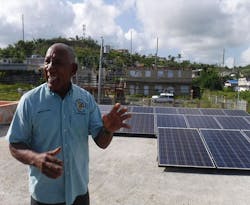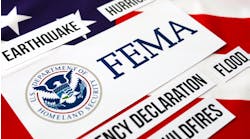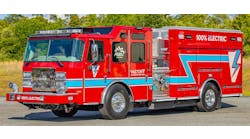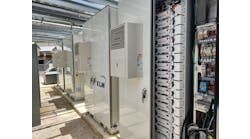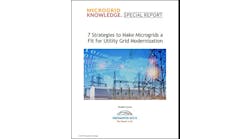Resilient Power Puerto Rico, a non-profit energy relief effort, is scaling up its operations, installing solar-storage microgrids in towns and communities, readying the island as yet another hurricane season approaches.
*Credit: Jan Curet, RPPR
With a goal to raise $2.5 million and install 100 community-centered microgrids across Puerto Rico, the organization recently received $625,000 from Banco Popular’s charitable foundation, Acacia Network, the Ayuda Puerto Rico Fund and the PRxPR fund.
The initial funding will be used to install 25 solar-storage microgrids with partners, including Tesla and island-based solar businesses. The microgrids will be donated to organizations that provide critical social services — food, water, power, medical care, etc. — in small towns and communities that lost grid power.
Join us for a special discussion, “Puerto Rico: From Tragedy to Innovative Model for the World?” to be held at Microgrid 2018 on May 9 in Chicago.
The 25 microgrids are not the first effort by Resilient Power Puerto Rico. Since its launch in October by a small group of New York professionals with island ties, the non-profit has deployed 15 distributed solar-storage systems, six of which are microgrids connected to the distribution grid of government-owned utility, the Puerto Rico Electric Power Authority (PREPA).
Puerto Rico’s energy paradigm shift
As it expands its effort, Resilient Power Puerto Rico finds its mission — and government attitudes about clean energy — morphing.
“I think there’s something of a paradigm shift taking shape in Puerto Rico when it comes to energy,” said San Juan-born co-founder Cristina Roig, a New York corporate lawyer, told Microgrid Knowledge.
Because the organization’s projects have been small — 12-kW systems — Resilient Power Puerto Rico hasn’t needed to interact much with government and regulatory authorities. That’s changing as utility grid power is restored and the scope and scale of the non-profit’s project development plans expand.
“We continue to focus on providing clean, resilient power for community-centered organizations that provide social services in areas that still don’t have it, mostly in the interior, but we’re extending that to include those that provide healthcare and medical services as well,” Roig explained. “Clinics are going to require more energy storage capacity and infrastructure, so the scale of the microgrids is increasing.”
In light of the devastation caused by Hurricane Maria, emergency relief and disaster recovery efforts received temporary exemptions from some regulations. But that won’t continue forever.
“We haven’t had much interaction with them [PREPA, etc.], but as we scale up it’s inevitable that we will have to work more closely with regulators and authorities. Once you start powering up a municipality, they’re going to want those systems to be connected,” Roig said.
Fortunately, thinking is shifting among key government agencies, such as PREPA and the Army Corps. Roig said that they are opening up to the idea of using solar, renewables, energy storage and microgrids.
“It’s more of a political issue, and not one we necessarily want to get into, but I think the fact that we see PREPA considering them [microgrids] is significant. We want to work with whatever energy authority is in place insofar as they’re aligned with our basic mission of getting people and communities powered up,” Roig said.
*Credit: Jan Curet, RPPR
Preparing for the next big one
Hurricane season starts in June and extends through November in the Caribbean. Organizations with microgrids will be ready to provide social services if another disaster strikes. “Basically, we’re installing these microgrids to create resiliency in advance of the next one,” Roig said.
Providing refrigeration so that clinics can stock up and store medicine, such as insulin, is a focal point. “Many people who rely on insulin suffered as a result of the lack of power for refrigeration,” Roig said. “We’re now trying to prepare for the next one. Given the ability to generate and distribute power independently of the utility grid, they’ll be able to avoid the types of calamities that occurred [in Maria’s wake].”
Resilient Power Puerto Rico reserves the right to access microgrid sites to ensure they are being operated in accordance with the non-profit’s requirement that they’re used to provide local social services, as well as comply with electrical codes and other regulations. The organization also monitors microgrid usage and acquires related data. Some of the data is shared with Resilient Power Puerto Rico’s donors.
“Necessity is the mother of invention,” Roig said. ‘The hurricane hit and left the electric power authority bare and exposed. At the same time, actually well before, they [government leaders and PREPA] were looking at breaking up and privatizing PREPA. Everything is being looked at with fresh eyes, at least we hope that’s the case in more than just appearance. If the right people come in with open minds I believe that a lot of different possible models can work – pure renewables, hybrids. We just see ourselves, and solar-storage microgrids, as one of those possibilities.”
About Resilient Power Puerto Rico
Resilient Power Puerto Rico was modeled after a similar organization in New York, Power Rockaways Resilience, formed in the wake of Superstorm Sandy.
The organization works with a variety of partners to site, design and install solar-storage systems and microgrids. AZ Engineering has designed its systems, while installation has been handled by New Energy, Pro Service and Green Energy Systems, according to project volunteer Jan Curet, a native Puerto Rican employed by Marvel Architects, whose founding principal, Jonathan Marvel, co-founded Resilient Power. Two more local solar installation companies, NEO ERA and ecologicAll are set to join the list.
The project partners also train local residents of recipient community-centered organizations to operate and maintain the energy installations. It’s then up to the local organizations to operate them in accordance with regulatory requirements.
Along with primarily donated solar panels, the distributed energy and microgrids installed to date use Tesla Powerwalls for battery energy storage.
Track news about microgrids in Puerto Rico by subscribing to the free Microgrid Knowledge newsletter.
